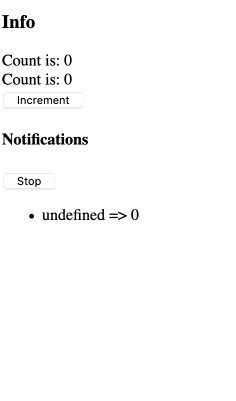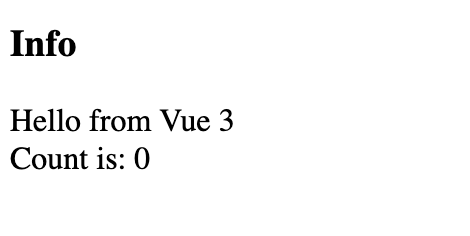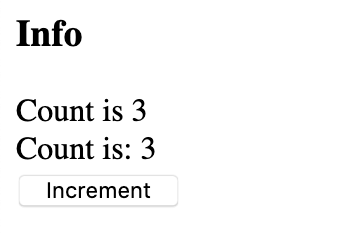In this article we compile Vue 3 from the latest source and try out some of the new APIs, include the upcoming composition API. This is the app we will be building:

I’ll take a look at the new composition API. You can read the RFC here. Sine Vue 3 is still under active development, and not even available on npm yet, some features and APIs may change - this article reflects the current state as of the 14th of Nov, 2019.
As we get closer to Vue 3, the best place for official learning resources is VueSchool’s upcoming Vue 3 course, by Vue 3 contributors Alex Kyriakidis and Chris Fritz. In the meantime, the best resource I’ve found that covers everything is their Master Class. They have a Black Friday sale coming up, so check that out if you want to learn more about Vue and Vue 3!
Getting and Compiling Vue 3
To get started with Vue 3, clone the vue-next repo: git clone https://github.com/vuejs/vue-next.git. Now, cd vue-next and install the dependencies by running yarn install, then build the packages by running yarn build. This might take a while.
Next, we need a minimal index.ts and index.html. index.html looks like this:
<!DOCTYPE html>
<html lang="en">
<head>
<meta charset="UTF-8">
<meta name="viewport" content="width=device-width, initial-scale=1.0">
<meta http-equiv="X-UA-Compatible" content="ie=edge">
<title>Document</title>
<script src="./packages/vue/dist/vue.global.js"></script>
<script src="./dist/bundle.js"></script>
</head>
<body>
<div id="app"></div>
</body>
</html>We have added two script tags - one for the ./dist/bundle.js we will be compiling soon, and one for the browser build of Vue 3, which was compiled when we ran yarn build in the packages/vue/dist/vue.global.js directory.
Next, add a basic index.ts:
And index.ts:
export {}Since we will use TypeScript, we will need a few dependencies and a basic webpack.config.js to compile for use in a browser. Install them:
yarn add yarn add awesome-typescript-loader source-map-loader webpack-cli webpack -WWe need -W since we are currently are in a git repository containing several sub packages (in the packages directory, Vue 3 is very modular like that) and we want to install the dependencies to the top level. We will piggyback of the existing tsconfig.json - but we don’t want to watch the entire repository during development, since we have already built the project when we ran yarn build earlier. In the existing tsconfig.json, remove all the entires in the "include" array.
Next, I created a webpack.config.js and added the following:
const path = require('path')
const { CheckerPlugin } = require('awesome-typescript-loader')
module.exports = {
entry: './index.ts',
devtool: 'source-map',
output: {
path: path.resolve(__dirname, 'dist'),
filename: 'bundle.js'
},
module: {
rules: [
{
test: /\.ts/,
exclude: /node_modules/,
loader: 'awesome-typescript-loader'
},
{ enforce: 'pre', test: /\.js$/, loader: 'source-map-loader' }
]
},
resolve: {
extensions: ['.ts', '.js']
},
plugins: [new CheckerPlugin()]
}Okay, now we are ready to start hacking. I had bit of trouble getting everything to work - I was really hoping to import a bunch of TypeScript methods and get autocompletion out of the box, but either I didn’t build the packages right or I’m missing something, or it’s just too early for that in development of Vue 3. So we will need some type definitions. The TypeScript experience is, to me, the killer feature of Vue 3, not the new APIs or other features.
Building an App with Vue 3 and TypeScipt
Start by updaing index.ts with the following:
interface IVueNextAPI {
createApp: () => {
mount: (appEl: object, selector: string) => void
}
}
declare global {
interface Window {
Vue: IVueNextAPI
}
}
interface InfoProps {
count: string
message: string
}
const Info = {
setup(props: InfoProps) {
return props
},
template: `
<div>
<h3>Info</h3>
<div>{{ message }}</div>
<div>Count is: {{ count }}</div>
</div>
`
}
interface AppSetup {
count: number
}
const App = {
components: {
Info
},
setup(): AppSetup {
return {
count: 0
}
},
template: `
<Info
:count="count"
message="Hello from Vue 3"
/>
`
}
window.addEventListener('DOMContentLoaded', () => {
window.Vue.createApp().mount(App, '#app')
})
export {}I tried using the definitions generated during the yarn build step earlier, but I couldn’t get it working - TS errors everywhere, so for now I just made some minimal types to get us started. We no longer do const app = new Vue(....).$mount('#app') anymore - Vue 3 exposes a createApp function, which returns a mount method to which you pass your root component and selector.
Ideally, we would use tsx in render functions, however I couldn’t get that working either, so for now I’ll just use string literals with template. In the future, tsx and render functions will be supported, and we should be able to get static typechecking on our templates, like in React when using tsx!
You can see there is now a setup function, which takes the props as the first argument, as shown in the Info component. Since App is the top level component, it does not receive any props. setup returns and object which is what would be saved in data and computed fields in the current Vue 2 API. This will still be an option in Vue 3, as well.
Whatever you return from setup are made available in the template function. I like to define this object as XXXSetup, where XXX is the name of component. It’s like a schema for your component; it tells the developer what the setup function’s API looks like. Think of it like a form a documentation.
setup is called once, when the component is created for the first time (like the existing created lifecycle method). The above code renders the following entirely uninteresting Vue app:

Let’s explore some more of the new APIs.
Using reactive
Vue now exposes a reactive method. This lets us make any object… reactive. The type definition looks like this, taken from here:
interface IVueNextAPI {
createApp: () => {
mount: (appEl: object, selector: string) => void
}
reactive: <T extends object>(raw: T) => T
}We can update the setup function in App using the new reactive function. reactive takes an object - count is a primitive. You can use another new API, ref, for primitive values, but for now let’s use reactive with a count key. This will make it easy to add more reactive properties soon. They are actually slightly difference, you can read more here in the RFC.
Update App:
interface AppSetup {
state: {
count: number
}
increment: () => void
}
const App = {
components: {
Info
},
setup(): AppSetup {
const state = window.Vue.reactive({ count: 0 })
const increment = () => {
state.count += 1
}
return {
state,
increment
}
},
template: `
<Info
:count="state.count"
message="Hello from Vue 3"
:increment="increment"
/>
`
}Next, update Info to use the new increment function:
interface InfoProps {
count: string
message: string
increment: () => void
}
const Info = {
setup(props: InfoProps) {
return props
},
template: `
<div>
<h3>Info</h3>
<div>{{ message }}</div>
<div>Count is: {{ count }}</div>
<button @click="increment">Increment</button>
</div>
`
}Clicking the increment updates the count, using Vue’s mutation based update logic. Next I’ll show how to use the computed API.
computed
Let’s say we want the message prop to be dynamic, based on the value of count. We can use computed. Update the type definition, which in it’s basic form is the same as reactive. Also update App:
interface AppSetup {
state: {
count: number
}
message: () => string
increment: () => void
}
const App = {
components: {
Info
},
setup(): AppSetup {
const state = window.Vue.reactive({
count: 0,
})
const increment = () => {
state.count += 1
}
return {
state,
increment,
message: window.Vue.computed(() => `Count is: ${state.count}`)
}
},
template: `
<Info
:count="state.count"
:message="message"
:increment="increment"
/>
`
}At first I tried to do message: \Count is ${state.count}`. That does not work.setuponly runs once - you will just get a string that does _not_ update reatively. You need to pass acomputed` function. This lets Vue keep track of the changes.

watch
Now we have two count messages that increment together. Let’s take a look at another familiar API from Vue 2, watch. There are quite a few type overloads if you dig deep into the repo, I’ll just demonstrate the simplest here.
type StopHandle = () => void
interface Ref<T> {
value: T
}
type WatcherSource<T> = Ref<T> | (() => T)
interface IVueNextAPI {
createApp: () => {
mount: (appEl: object, selector: string) => void
}
reactive: <T extends object>(raw: T) => T
computed: <T extends object>(raw: T) => T
watch<T>(
source: WatcherSource<T>,
effect: (
value: T,
oldValue: T,
) => void,
): StopHandle
}watch now returns a stop function, which you can call to cancel the watching. It’s a bit easier to understand once you see it in action. I’ll also add a bit more type safety to the AppSetup:
interface State {
count: number
notifications: Array<{ id: number, content: string }>
}
interface AppSetup {
state: State
message: () => string
increment: () => void
stop: () => void
}
const App = {
components: {
Info
},
setup(): AppSetup {
const state: State = window.Vue.reactive({
count: 0,
notifications: []
})
const increment = () => {
state.count += 1
}
const stop = window.Vue.watch(() => state.count, (val, oldVal) => {
state.notifications.push(
{
id: state.notifications.length + 1,
content: `${oldVal} => ${val}`
}
)
})
return {
state,
increment,
stop,
message: window.Vue.computed(() => `Count is: ${state.count}`)
}
},
template: `
<Info
:count="state.count"
:notifications="state.notifications"
:message="message"
:increment="increment"
:stop="stop"
/>
`
}watch, takes a function, which should reutrn the reactive object to watch. The next argument is a callback which is called when the watched value mutates. The callback receives the newly updated value and the previous value, just as it does in Vue 2.
In the body of the callback, you implement whatever you want to occur when the value changes. In this case, I push to an array, showing how the value changed. watch returns a function which I called stop. When you call stop, the watcher will cease to watch the values.
The updated Info implementation using stop and displaying notifications is as follows:
interface InfoProps {
count: string
message: string
notifications: Array<{ id: number, content: string }>
increment: () => void
stop: () => void
}
const Info = {
setup(props: InfoProps) {
return props
},
template: `
<div>
<h3>Info</h3>
<div>{{ message }}</div>
<div>Count is: {{ count }}</div>
<button @click="increment">Increment</button>
<h4>Notifications</h4>
<button @click="stop">Stop</button>
<ul>
<li v-for="notification in notifications" :key="notification.id">
{{ notification.content }}
</li>
</ul>
</div>
`
}
This is a pretty basic app, but it does a good job of showing of the new Vue 3 composition API.
Thoughts
The new composition API RFC has received mixed feedback from the community. One thing I think is important to remember is the composition API is additive - none of the existing Vue 2 APIs is going away. Here are some of nice things about it, and Vue 3 in general:
- The entire codebase is in TypeScript, which means we get better type checking and assistance from the IDE.
- The composition API allows for better Typescript support. I think this is the real killer feature - I don’t have a strong opinion on which API I like better, I just want to have type safety so I can build bug free applications and deliver value to clients.
- It is certainly a departure from what I first liked about Vue - simple and seemingly “magic” reactivity.
- Good support for
tsx- not my preferred way to write templates, but if it means better type safety, I’ll take it.
Some of the cons are:
- Two ways to write Vue components - just because you know one Vue app well, another might be completely different. This is kind of how I feel about React now. Some codebases use
classcomponent with lifecycle methods, and other usefunctioncomponents with the new React hooks. It’s a bit tiring to learn so many ways to do the same thing. - likely more work to write a plugin supporting two different APIs.
- You need to learn something new. If you don’t like learning new things, you probably don’t belong in the modern JS world anyway. Not sure if this is a good or bad thing :shrug:
Conclusion
We explored the new composition API and Vue 3 by compiling it from source. Exciting times are ahead!
For more learning resources, I’ve found Vue School to have the best courses. The teachers, Alex and Chris, are core contributors to Vue and the upcoming Vue 3, and have been for many years. They were a big help to me when learning Vue. They also have an upcoming Vue 3 master class which I’m looking forward to. Alex mentioned they have a big sale coming up for Black Friday, so check their courses out if you looking for more Vue resources.